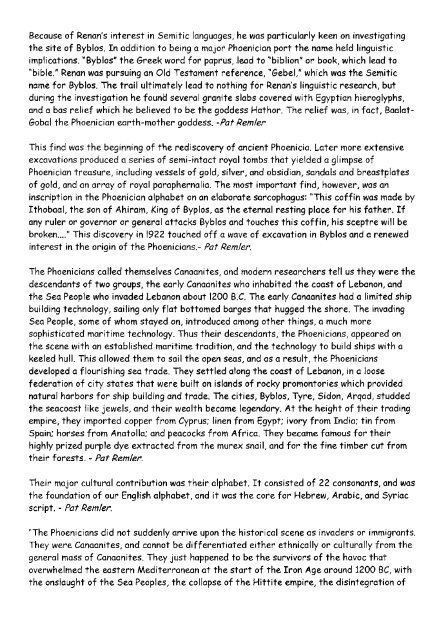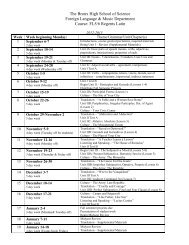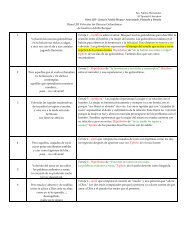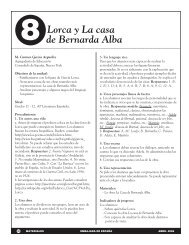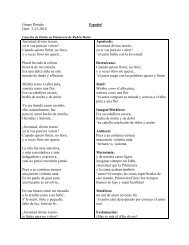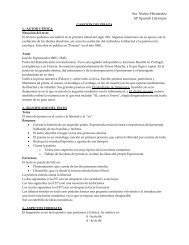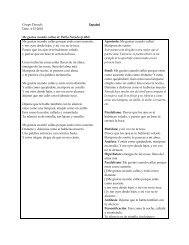Phoenicians.pdf
Phoenicians.pdf
Phoenicians.pdf
Create successful ePaper yourself
Turn your PDF publications into a flip-book with our unique Google optimized e-Paper software.
Because of Renan's interest in Semitic languages, he was particularly keen on investigating<br />
the site of Byblos. I n addition to being a major Phoenician port the name held linguistic<br />
implications. "Byblos" the Greek word for paprus,.lead to "biblion" or book, which lead to<br />
"bible." Renan was pursuing an Old Testament reference, "Gebel," which was the Semitic<br />
name for Byblos. The trail ultimately lead to nothing for Renan's linguistic research, but<br />
during the investigation he found several granite slabs covered with Egyptian hieroglyphs,<br />
and a bas relief which he believed to be the goddess Hathor. The relief was, in fact, Baalat-<br />
Gobal the Phoenician earth-mother goddess. -Pat Remler<br />
This find was the beginning of the rediscovery of ancient Phoenicia. Later more extensive<br />
excavations produced a series of semi-intact royal tombs that yielded a glimpse of<br />
Phoenician treasure, including vessels of gold, silver, and obsidian, sandals and breastplates<br />
of gold, and an array of royal paraphernalia. The most important find, however, was an<br />
inscription in the Phoenician alphabet on an elaborate sarcophagus: "This coffin was made by<br />
Ithobaal, the son of Ahiram, King of Byplos, as the eternal resting place for his father. If<br />
any ruler or governor or general attacks Byblos and touches this coffin, his sceptre will be<br />
broken ...." This discovery in 1922 touched off a wave of excavation in Byblos and a renewed<br />
interest in the origin of the <strong>Phoenicians</strong>.- Pat Remler.<br />
The <strong>Phoenicians</strong> called themselves Canaanites, and modern researchers tell us they were the<br />
descendants of two groups, the early Canaanites who inhabited the coast of Lebanon, and<br />
the Sea People who invaded Lebanon about 1200 B.C. The early Canaanites had a limited ship<br />
building technology, sailing only flat bottomed barges that hugged the shore. The invading<br />
Sea People, some of whom stayed on, introduced among other things, a much more<br />
sophisticated maritime technology. Thus their descendants, the <strong>Phoenicians</strong>, appeared on<br />
the scene with on established maritime tradition, and the technology to build ships with o<br />
keeled hull. This allowed them to sail the open seas, and as a result, the <strong>Phoenicians</strong><br />
developed a flourishing sea trade. They settled along the coast of Lebanon, in a loose<br />
federation of city states that were built on islands of rocky promontories which provided<br />
natural harbors for ship building and trade. The cities, Byblos, Tyre, Sidon, Arqad, studded<br />
the seacoast like jewels, and their wealth became legendary. At the height of their trading<br />
empire, they imported copper from Cyprus: linen from Egypt; ivory from India: tin from<br />
Spain: horses from Anatolla: and peacocks from Africa. They became famous for their<br />
highly prized purple dye extracted from the murex snail, and for the fine timber cut from<br />
their forests. - Pat Remler.<br />
Their major cultural contribution was their alphabet. It consisted of 22 consonants, and was<br />
the foundation of our English alphabet, and it was the core for Hebrew, Arobic, and Syriac<br />
script. - Pat Remler.<br />
"The <strong>Phoenicians</strong> did not suddenly arrive upon the historical scene as invaders or immigrants.<br />
They were Canaanites, and cannot be differentiated either ethnically or culturally from the<br />
general mass of Canaanites. They just happened to be the survivors of the havoc that<br />
overwhelmed the eastern Mediterranean at the start of the Iron Age around 1200 BC, with<br />
the onslaught of the Sea Peoples, the collapse of the Hittite empire, the disintegration of


